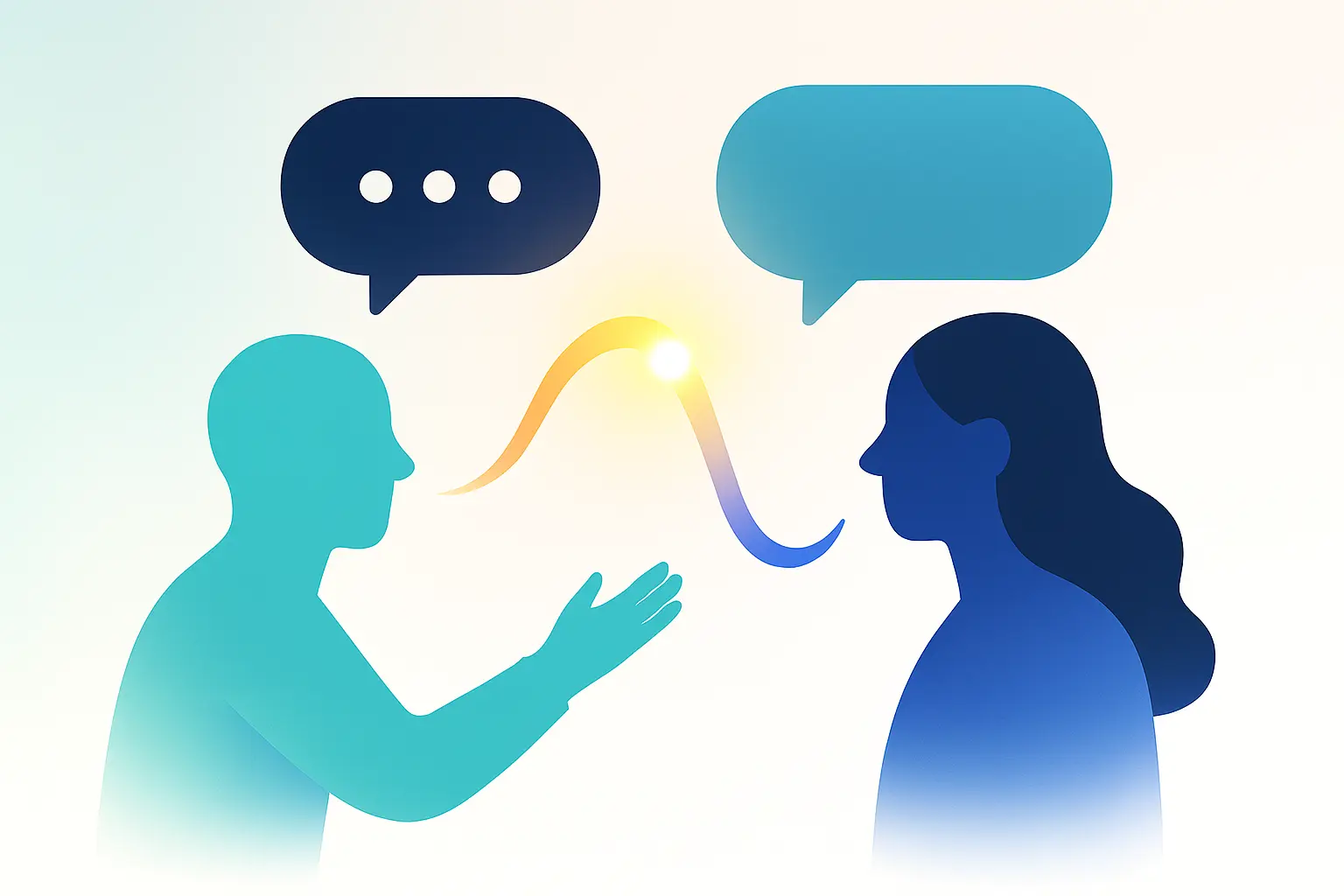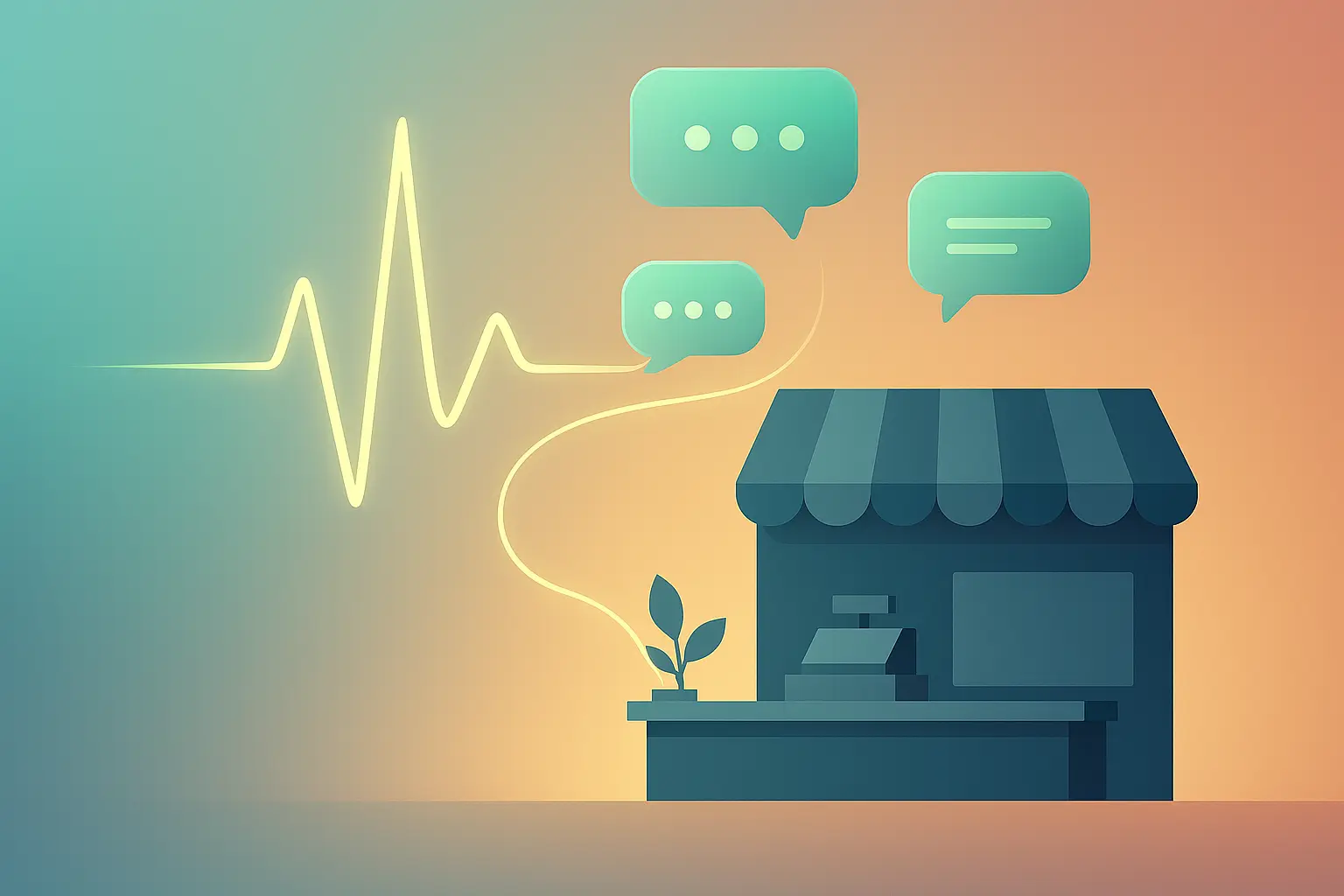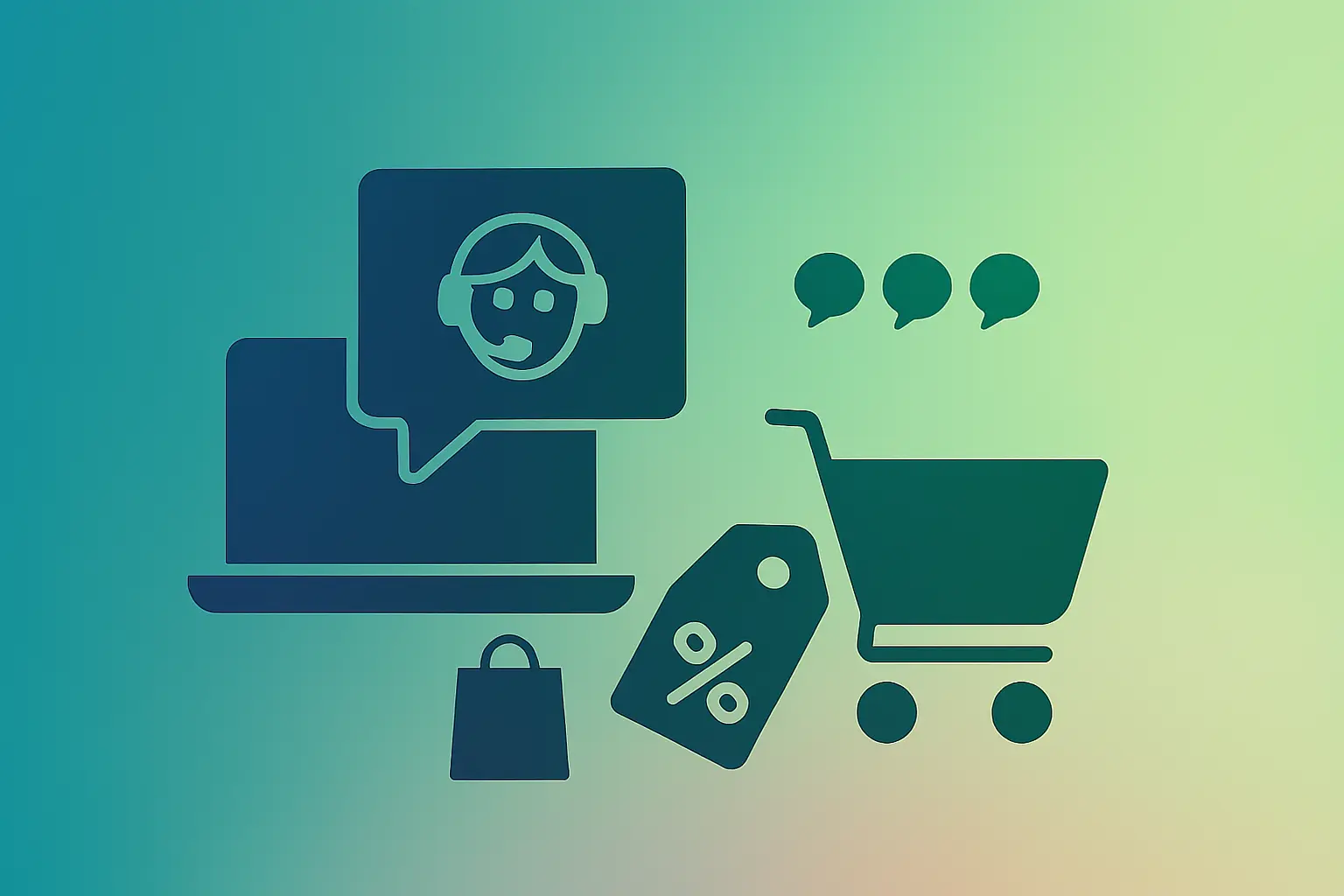12 Live Chat Metrics & KPIs to Measure Customer Service
- January 4, 2018
- 20 mins read
- Listen

Stop there if you are also facing the following problems-
- There is no clear data to improve live chat for better sales
- Finding it hard to prove the value of live chat to decision-makers
- Challenges in tracking how satisfied customers are during chat
- Difficulty in evaluating how well support agents are performing
- Inconsistent customer experiences across different channels, especially live chat
Live chat metrics are the ultimate solution for all of your problems. It is a powerful tool for real-time customer support. However, to truly benefit, businesses must track key live chat metrics and KPIs.
To get the solution, you’re in the right place! In this article, we’ll simplify the key live chat metrics you need to track for better insight into your customer support performance. Plus, we’ll share important and actionable tips to help you improve these metrics. Let’s begin!
The businesses that implement live chat require a thorough understanding of the key performance indicators (KPIs).
What are Live Chat Metrics?
Live chat metrics are performance indicators used to measure the efficiency and effectiveness of live chat support for improving customer satisfaction and operational efficiency.
These tools help businesses track various aspects such as response times, customer satisfaction, resolution efficiency, and the overall impact of live chat on business objectives like sales and customer retention.
By analyzing live chat metrics, businesses can assess the quality of their service, optimize agent performance, and enhance the customer experience. Common metrics include First Response Time, Customer Satisfaction (CSAT), Average Resolution Time, and Chat Volume.
12 Live Chat Metrics & Key Performance Indicators (KPIs)
As you know, implementing live chat is definitely easy but the tough part is measuring your live chat’s success. By continuous measurement of the chat support metrics and KPIs, you can improve the chat performance experience of your customers as well as the chat support skills of your team.
Here are the key live chat performance metrics that you should keep an eye on to measure the effectiveness of your live chat on a regular basis.
1. First Response Time (FRT)
First Response Time (FRT) also known as first reply time is a key live chat metric that refers to how long customers with problems have to wait for the initial response of the support agent.
While the first response time measures the average time it takes for the support agent to reply, it is the first step in finding an effective solution. This chat plays a significant role in customer satisfaction. The lower your first response rate, the more satisfied your customers will be, both with your customer service team and with your brand.
Satisfied customers become sticky customers with a higher Customer Lifetime Value (CLTV) making them more profitable for your business. As per Hub Spot Research, “90% of customers are likely to purchase more than once with better customer service.”
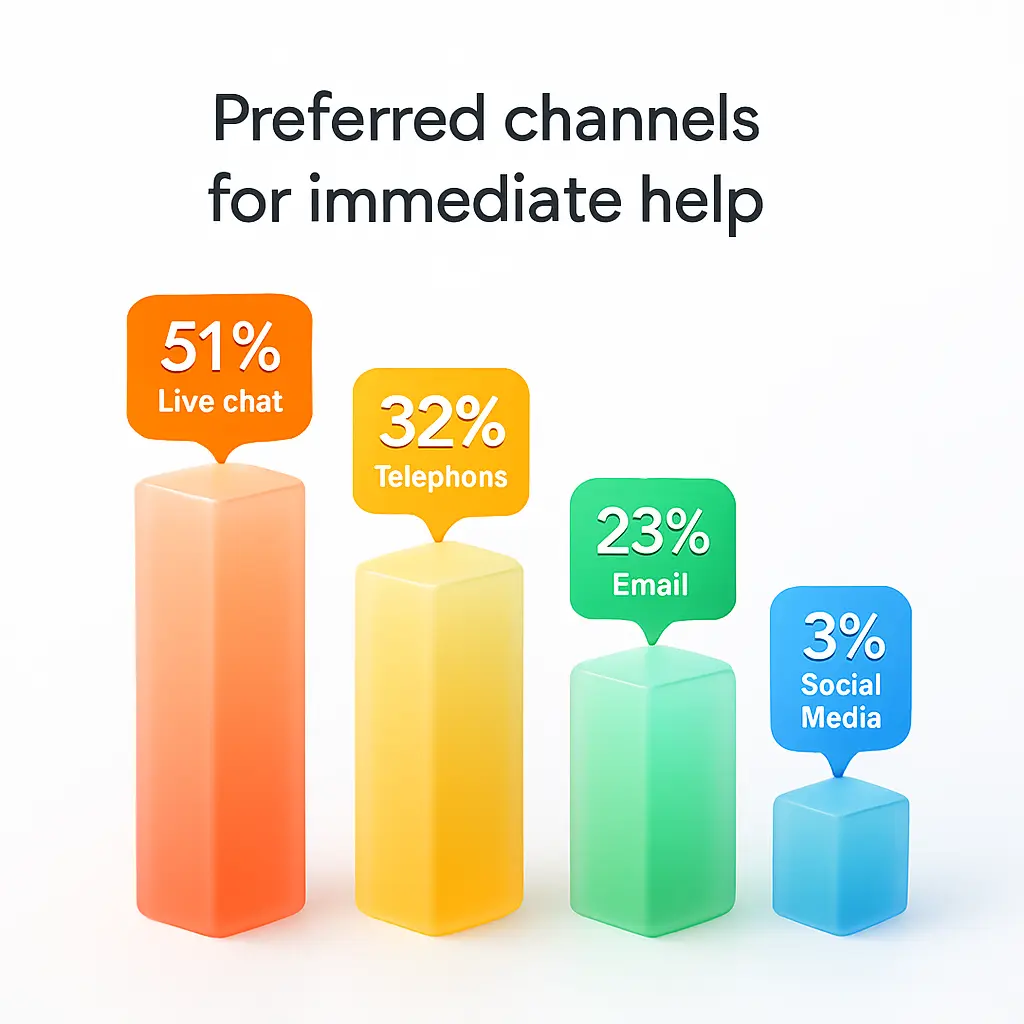
Live chat helps to provide real-time support, which is why it is a popular channel preferred for customer communication. Here are some tips on how you can improve live chat response time.
- Number of resources – You need to have hired well-trained support agents to handle conversations effectively in real-time.
- Deploy chatbots – Use AI chatbots to engage customers 24×7 by providing an instant response for simple queries when your team is busy or unavailable.
- Use canned responses – Prepare answers for FAQs beforehand and use them during conversations to respond faster.
- Enable routing – Routing helps to connect the customer with the right agent or department to provide a faster and more effective response.
With REVE Chat and its customer service tools, you will find it easy to improve your first response time. Start a free trial of the top-rated customer engagement tools and start delivering instant responses to users.
2. Total Number of Chats
A total number of chats refers to one of the vital lead generation metrics via live chat that measures the successful chat sessions from the total number of chats. The more engaged chats indicate that you have engaged your website visitors effectively.
The live chat performance metric also helps you to know the problems and queries your customers are having. When there is an issue with your product or website, you will see a surge in the number of chats initiated. Here are some tips to be followed:
- While analyzing if you find that most of the queries are related to particular information, you can create a FAQ page covering all the details or make it appear on the most visited pages.
- You not only need to check the number of chats but also the content of the chats in the chat history.
3. Average Resolution Time (ART)
Average Resolution Time (ART) refers to the average time taken by the support agents to close the conversations. Also known as the average handle time, the chat metric helps to measure customer satisfaction.
The lesser chat resolution time indicates that less time was used to resolve the issues and it has a negative impact on the customer satisfaction rate.
The higher average handle time means the customers are waiting a long time in between responses. That might mean that your agents are handling too many chats at once, or just juggling too many tasks. Focus on managing your chat queue more efficiently, additional training or guidance to address issues quicker.
Live chat empowers you to connect and acquire first-hand customer information in real-time. The agents can use different engagement tools (co-browsing & video chat) to resolve the issues in the first contact. You can follow the below tips to maintain the ART chat KPI:
- Integrate your live chat at the places your customers hang on the most.
- Train your agents with strong interpersonal skills to handle chats effectively.
- Use canned responses to deliver faster replies to customer FAQs.
- Rout the chats across the right team for quicker response.
4. Chat to Conversion Rate
Live chat is a great channel for lead generation. 38% of customers have said that they have ended up making a purchase due to a good live chat session. By providing real-time assistance to sales queries, live chat helps in converting sales leads by maximizing your return on investment (ROI).
The chat-to-conversion rate metric means the total number of visitors converted, out of the total number of visitors who hand-chatted with a live chat agent.
Tracking this chat metric can be a good indicator to know if the efforts made by agents are effective or not. The successful conversion can vary with business goals. It can be a purchase, a sign-up for the newsletter, or just attending a webinar. You can follow the below tips to increase conversion rates.
- Start a proactive chat with customers when they are on a specific page and resolve all their queries.
- You can trigger personalized welcome messages when visitors land on your website.
- Use AI chatbots to qualify leads by asking preset questionnaires and transfer to the sales team.
5. First Contact Resolution Rate (FCR)
The Ascent Group research shows that 60% of companies that measure FCR for 1+ year report a 1 to 30% improvement in their performance.
First call resolution (FCR) is an important call center metric that measures the ability to resolve customer problems, questions, or needs the first time they call, with no follow-up required.
FCR is almost always associated with customer satisfaction – the higher your first contact resolution rate, the more satisfied your customers tend to be and drives customer loyalty.
The call center metric measures how effectively your service desk conducts its business and is a function of many factors, including the complexity and types of transactions handled, the experience of your agents, the quality of agent training, and the tools that are available to your agents.
Live chat is the most preferred channel as it provides real-time analytics that help to deliver effective answers to customer queries and increase customer satisfaction. Here are some tips on how live chat KPI can improve performance:
- Train your support agents – After setting your business goals, agent training is the most important step in achieving improved FCR.
- Measure on multiple channels – A high FCR on phone calls, but a lower on chats is not a good sign. Make sure you are measuring across all communication channels.
Learn more: Ways for Achieving First Contact Resolution with Live Chat Support
6. Customer Satisfaction Score (CSAT)
The Customer Satisfaction Score (CSAT) is the most popular customer experience metric that directly measures customer satisfaction levels. A CSAT survey usually showcases a question asking clients how satisfied they are with a certain service, product, or interaction with your brand. Here’s an example of a CSAT question:
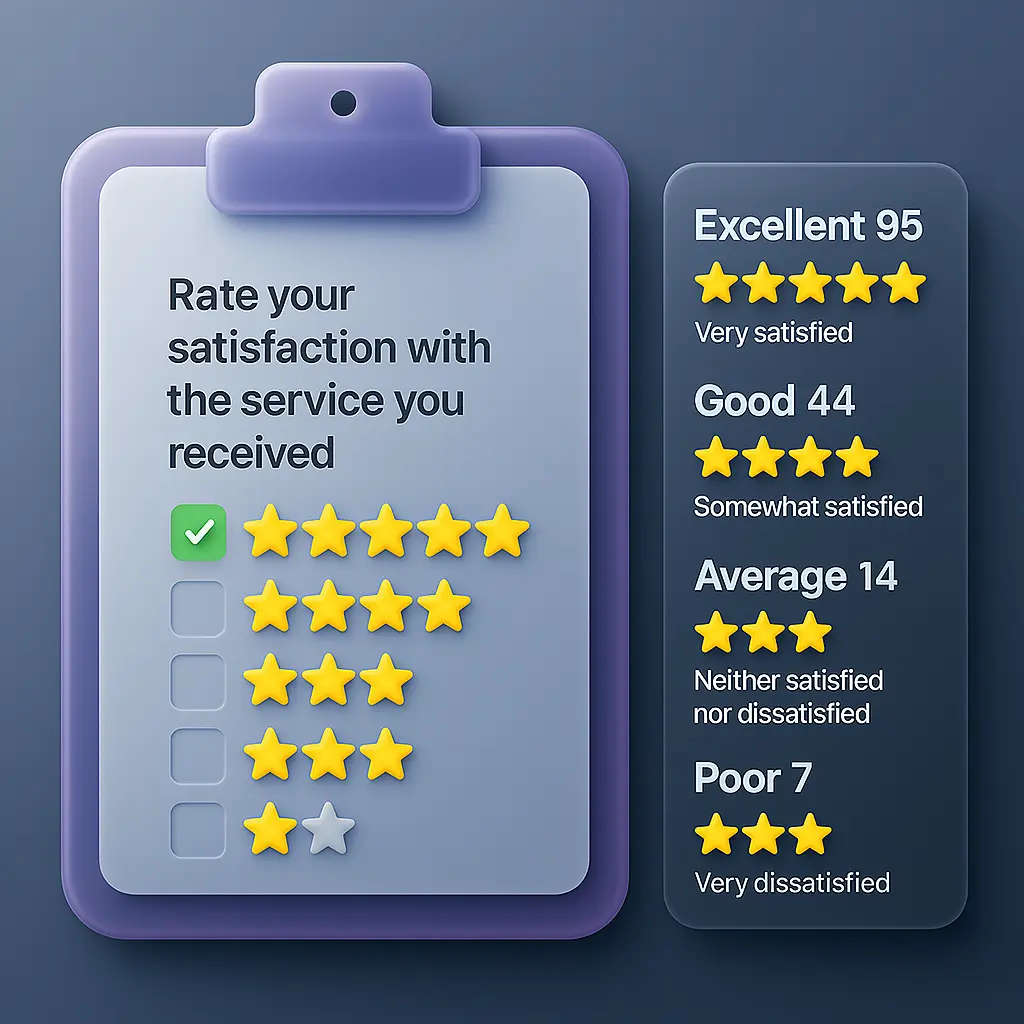
The chat metric helps in gauging the ‘happiness’ resulting from recent customer service interactions, which is valuable information, especially when you have added or updated new features and need to track the results.
Learn more: How to Measure Customer Satisfaction
7. Net Promoter Score (NPS)
Net Promoter Score (NPS) is a customer loyalty metric that measures customer satisfaction using an index that ranges from -100 to 100. The key metric helps to find out:
- How satisfied customers are your products, services, and solutions
- How loyal they are towards your business
- How likely they are to recommend your brand to their family and friends
NPS surveys have a common to ask customers i.e. how likely they are to recommend your products, services, or brand to other people.
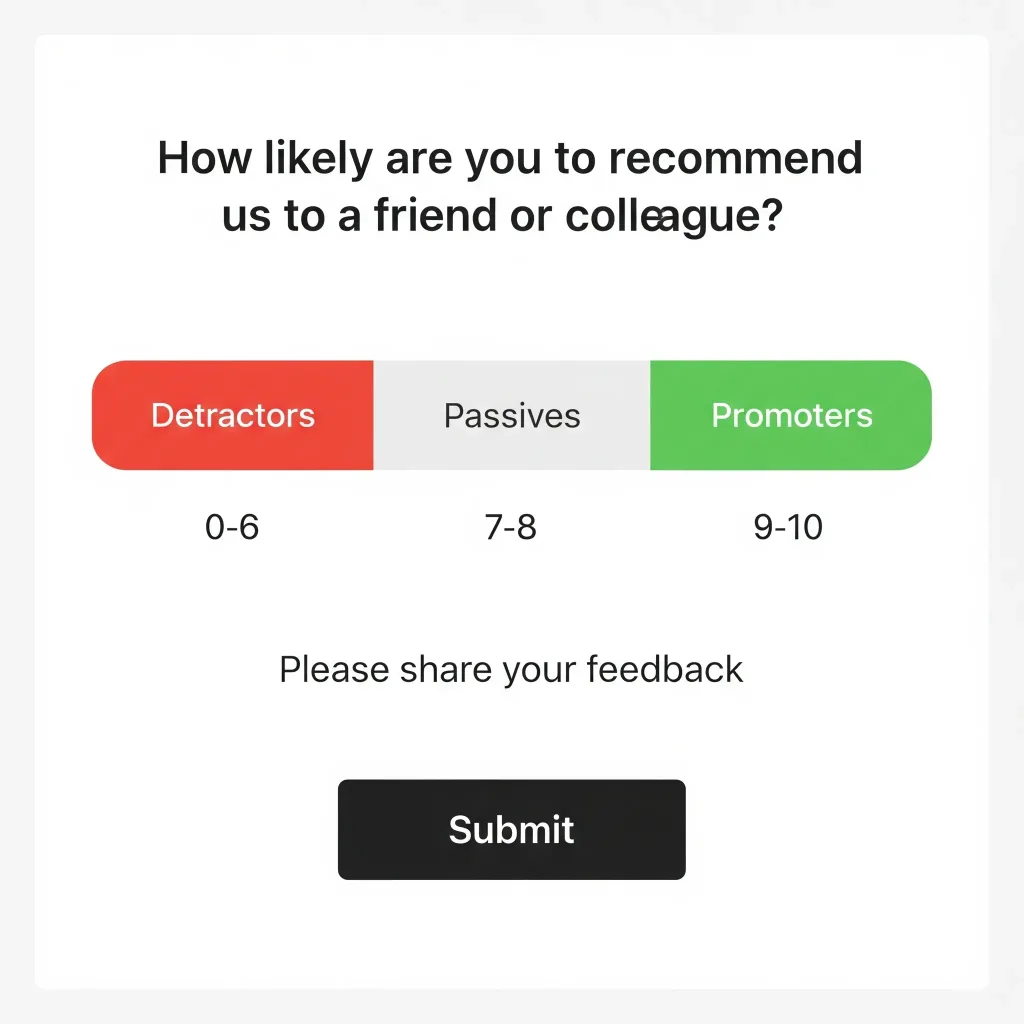
Based on the scores, customers are further categorized into three categories: detractors (0-6), passives (0-8), and promoters (9 or 10). and the NPS score is calculated.
Hence, you have to prepare the right set of questionnaires for the right group to collect honest feedback. HBR says acquiring a new customer is anywhere from 5 to 25 times more expensive than retaining the existing one. Some tips you can follow:
- Engage with detractors to find out what went wrong, and why are they not happy with your product or service.
- Be in touch with your promoters to know what can be improved as they are more open to feedback as compared to detractors.
8. Average Wait Time
The longer you make your customers wait, the less important they feel. Knowing how long it takes to answer customer calls can help you answer that question, and Average Wait Time has become a call center metric for the same reason.
Average Wait Time (AWT), also known as Average Speed of Answer (ASA), is the average time a customer has to wait in a queue. The wait time differs based on the average handle time. American Express study found that the maximum amount of time callers were willing to wait was a whopping 13 minutes.
Measuring waiting or queue time helps to understand whether your chat support is over-utilized and may not perform effectively. With live chat, you can handle multiple chats simultaneously which reduces the queue time significantly. Here are the key ways you can reduce the wait time:
- Increase the number of concurrent chats an agent is currently allowed to handle.
- Automatically route the chats across the right departments for faster responses.
- Use canned messages to reduce response time and reduce chat duration.
9. Website Visitors to Chats
Websites are one of the main sources for businesses to acquire leads. By implementing live chat, prospects can be converted into leads by proactive engagement with personalized messages at the right time.
Tracking this chat performance metric helps in identifying the number of visitors converting successfully out of the total number of website visitors. If the conversion rate is low, it means you have to improve your website engagement strategies. Assisting customers in real time develops trust and improves the brand experience.
10. Missed Chats
Another live chat KPI is essential to track missed chats. The main purpose of live chat is to use the power of analytics and make it actively available to your prospects and customers. If you are missing out on chats for whatever may be the reason, it has a negative impact on your brand reputation. INC says, “51% of consumers say a business needs to be available 24×7.”
Missed chats are gone opportunities for you to engage with customers and prospects. It mainly depends upon your availability. If your team is missing a lot of chats it means you do not have enough resources to handle chat conversations effectively or the agents are not deployed at the specific time. Here are key tips to combat the missed conversations scenario:
- You can use chatbots to engage customers 24×7 to answer FAQs as not all conversations require manual support.
- Balance the chat conversations with bots and humans – Let bots handle the basic queries and complex queries by support reps.
11. Tags
Tags help you to understand what common queries are coming to live chat. If we are getting many chats where the topics are about shipping info, sales-related queries, demo schedule, pricing, etc, then it shows that the information is not clear to the customer on the website. It is good to use chat tags as a live chat metric as it gives you information about what are the areas you need to improve.
For e.g. Out of 30 tags received, say 10 are for shipping duration, 10 are for pricing. It means you provide relevant information about shipping time and pricing on the support section to provide customers all details in one go.
12. Total Number of Tickets
Total tickets track all tickets in your support queue over a period of time. Tracking the number of tickets is another live chat KPI that measures agent performance in handling support tickets. It is crucial to monitor from out of total chats assigned, how many of them were solved, and, more importantly, how many of them are still pending.
Based on the evaluation, you can learn how capable are your agents to resolve the tickets. This will help you to decide the need for additional resources for a ticket-solving team or not and if there are any complex issues.
Role of Live Chat Metrics in Increasing Customer Engagement & Customer Service
Live Chat is a vital tool for modern customer service. It offers real-time assistance and enhances user experience. Live chat metrics help improve customer engagement and service quality. Let’s have a look at the core role of live chat metrics in increasing customer engagement.
Live Chat Metrics in Customer Engagement
- It understands customer needs. Metrics show how well you’re meeting customer expectations.
- It provides faster and more personalized responses. Because of metrics the quick and tailored interactions lead to higher satisfaction.
- It boosts engagement and satisfies customers. Satisfied customers are more likely to stay engaged and loyal to your brand.
Live Chat Metrics in Customer Service
- Live chat metrics measure team efficiency. Metrics like response time and resolution time highlight how quickly your team can assist customers.
- It optimizes chat handling. Shorter wait times mean more efficient customer service and the ability to help more customers.
- This enhances customer experience. Quick resolutions lead to better interactions and increase overall customer satisfaction.
Live Chat Metrics in Chat Performance Analytics
- Live chat metrics help to identify pain points. Metrics like first-contact resolution and conversion rates reveal where customers may struggle.
- It makes proactive improvements. You can use data to update FAQs, improve agent training, and make other service adjustments.
- This drives better service and engagement. You can address issues in advance to create smoother experiences, and boost customer satisfaction and engagement.
The Importance of Measuring Live Chat Metrics
Measuring live chat metrics can help you with so many benefits. Let’s see the importance of measuring live chat metrics.
Customer Satisfaction
Customer satisfaction is at the heart of any successful business. Measuring customer satisfaction through live chat is like having a pulse on how well your support system is doing. When customers feel heard and helped quickly, they’re more likely to leave positive feedback.
Bill Gates once said, “Your most unhappy customers are your greatest source of learning.” Monitoring satisfaction allows businesses to make swift improvements that directly impact the customer experience.
Efficiency & Productivity
Live chat efficiency means solving problems faster and more effectively. The idea here aligns with Lean Management Theory, which focuses on reducing waste—wasted time, in this case. Tracking metrics like response and resolution times helps you understand if agents are handling chats smoothly.
The faster agents can resolve issues, the better. This doesn’t just benefit the company but leaves customers happier as well. In fact, studies have shown that live chat can improve efficiency by up to 50% compared to other channels.
Resource Allocation
Efficient use of resources can make or break a support system. Live chat data helps your businesses determine when and where your support is needed most.
The Pareto Principle, or the 80/20 rule says, “Often, 80% of your traffic happens in 20% of the time” Knowing this helps you allocate staff during high-demand periods. You can ensure that no customer waits too long for help. It’s all about smarter staffing and better service.
Reducing Abandonment Rates
High abandonment rates in live chat often signal deeper issues, like long wait times or unclear instructions. Albert Einstein once said, “Strive not to be a success, but rather to be of value.”
In a live chat, reducing shopping cart abandonment rates means making sure each customer feels valued and supported. By reducing wait times or improving communication, you can keep customers engaged long enough to get the help they need, which in turn improves the customer experience.
Boosting Sales & Conversions
While live chat is mostly about support, it also has a direct link to sales. Customers often need just a little extra reassurance before making a purchase. If you have heard about Social Proof Theory, it suggests, that people are more likely to act when they see others doing the same.
Live chat offers real-time, human interaction that can make customers feel more confident in their choices. This leads them to higher conversion rates. Having someone there to answer questions at crucial moments makes all the difference.
Average Handling Time
This metric isn’t just about being fast, but also effective. As Parkinson’s Law suggests, “Work expands to fill the time available for its completion.” The quicker you can handle a query, the more you can get done.
Monitoring average handling time helps ensure that agents are not only quick but also resolving issues properly. Striking the right balance here enhances both productivity and customer satisfaction.
Targeted Ticket Achievement
You need to set and hit goals to maintain high performance. Regularly measuring whether agents meet ticket resolution targets keeps everyone on track.
It’s the practical application of Goal-Setting Theory, which states that clear, measurable goals lead to higher performance. Meeting these targets ensures that your team remains efficient, while customers receive timely and effective support.
Increase Conversion Rate
Tracking conversion rates in live chat is a clear indicator of how well the system is working. Converting a chat into a sale means that the customer got what they needed, both in terms of support and confidence.
Behavioral Economics suggests that timely, personalized interactions can nudge customers toward decisions, increasing the likelihood of conversions. It’s not about selling hard—just helping at the right moment.
Understanding Traffic Movement
Live chat is also a treasure trove of data about customer behavior. Understanding where your customers are coming from and what causes them to leave is crucial.
According to User Experience (UX) Theory, understanding the customer journey is important. When you identify the drop-off points or common areas of confusion in your business, you can fine-tune your approach and make the overall experience smoother and more engaging.
How to Measure Live Chat Performance
To measure the Live Chat performance you need to combine different user perspective statistics so that you can gain deep insight into your live chat team’s performance. Let’s see how we can measure live chat performance with REVE Live Chat.
For Managers (Team Oversight & Performance)
Managers can see the overall summary of live chat metrics as a snapshot of the performance and efficiency of the chat system. Here they can see-
Chat Duration
A long chat duration may indicate complex issues, while shorter sessions could mean faster problem-solving or incomplete resolutions. These metrics help managers monitor agent efficiency and identify when sessions may be taking longer than necessary, signaling a need for process optimization.
Calculation:
Chat Duration = End Time – Start Time
First Contact Resolution Rate (FCR)
A high FCR rate shows effective issue resolution and reduces customer frustration by minimizing repeated interactions. Allows managers to measure the effectiveness of agents in resolving issues and improving customer satisfaction.
Calculation:
FCR Rate = (Number of Issues Resolved on First Contact / Total Chats) x 100
Conversion Rate
High conversion rates indicate that chat interactions are effectively driving business goals. This helps managers gauge the success of chat interactions in achieving business objectives.
Calculation:
Conversion Rate = (Number of Conversions / Total Chat Sessions) x 100
For Agents (Daily Operations & Efficiency)
Chat Response Time
A short response time leads to higher customer satisfaction, while long waits can result in frustration and abandonment. Agents can track how quickly they acknowledge customer inquiries and work towards reducing response times to enhance customer experience.
Calculation:
Chat Response Time = Time of First Reply – Time of First Message
Queue Wait Time
Long wait times can frustrate customers and increase abandonment rates. Agents can monitor their efficiency and ensure they respond to customers in a timely manner, reducing customer wait times.
Calculation:
Queue Wait Time = Time of First Agent Response – Time of Initial Chat Initiation.
For Marketing/Business Development (Visitor Behavior & Engagement)
Chat Abandonment Rate
High abandonment rates may indicate that customers are getting frustrated with long wait times or technical issues. Marketing teams can use this to assess customer frustration levels and identify when engagement tactics need adjustment.
Calculation:
Chat Abandonment Rate = (Number of Abandoned Chats / Total Initiated Chats) x 100
For Data Analysts (Data Analysis & Insights)
Chat Response Time
A short response time leads to higher customer satisfaction, while long waits can result in frustration and abandonment. Analysts can use this data to determine overall response efficiency and highlight any outliers or patterns in the data for further investigation.
Calculation:
Chat Response Time = Time of First Reply – Time of First Message
First Contact Resolution Rate (FCR)
A high FCR rate shows effective issue resolution and reduces customer frustration. Analysts can track and report on how well issues are being resolved on first contact, helping to pinpoint areas for improvement.
Calculation:
FCR Rate = (Number of Issues Resolved on First Contact / Total Chats) x 100
For IT or Technical Teams (System Performance)
Chat Duration
Long chat durations may indicate inefficiencies or technical problems that need addressing. IT teams can monitor this to identify if long durations are due to system glitches or inefficiencies.
Calculation:
Chat Duration = End Time – Start Time
Queue Wait Time
Long wait times can indicate a lack of agent availability or technical issues. Helps IT teams evaluate system performance, identifying times when system overloads or technical glitches may occur.
Calculation:
Queue Wait Time = Timestamp of Agent Response – Timestamp of Initial Chat Initiation.
% Churn Rate= Sum of individual wait time/ total number of chat sessions
Final Thoughts on Live Chat Metrics & Analytics
Providing live chat support will help you connect with customers, improve their overall experience, and boost conversion. To accomplish all of these goals, measuring live chat metrics and analytics play a key role in improving your customer experience.
You can sign up to get the right support tools and add great value to your customer engagement effort.
Following the agent performance metrics and live chat support KPIs, you can deliver an amazing chat experience gain more satisfied customers, and accelerate the growth of your business.
Frequently Asked Questions
You can measure the effectiveness of live chat by tracking metrics like Customer Satisfaction (CSAT), First Contact Resolution (FCR), Conversion Rate, and Chat Abandonment Rate.
Chat monitoring is the process of tracking and reviewing live chat conversations between agents and customers. It helps ensure agents are following best practices, resolving issues effectively, and maintaining quality standards.
Live chat metrics are important because they provide valuable insights into how well your customer support is performing. These metrics help you to improve customer service by identifying areas for improvement, tracking agent productivity and efficiency, measuring customer satisfaction to ensure a positive experience, increasing conversions and sales by optimizing interactions, and making data-driven decisions to improve overall performance.
Live chat metrics are key performance indicators (KPIs) used to evaluate the effectiveness and efficiency of live chat services. They include metrics like response time, customer satisfaction, resolution rate, chat duration, and conversion rate. These metrics help businesses monitor and improve the quality of their customer support.
The average response time for live chat support should ideally be within 30 seconds. Quick responses keep customers engaged and reduce frustration, leading to better customer satisfaction and higher chances of completing a purchase or resolving an issue.


